90+ Latest Webinar Stats and Trends for 2025
Orange Owl
January 22, 2025
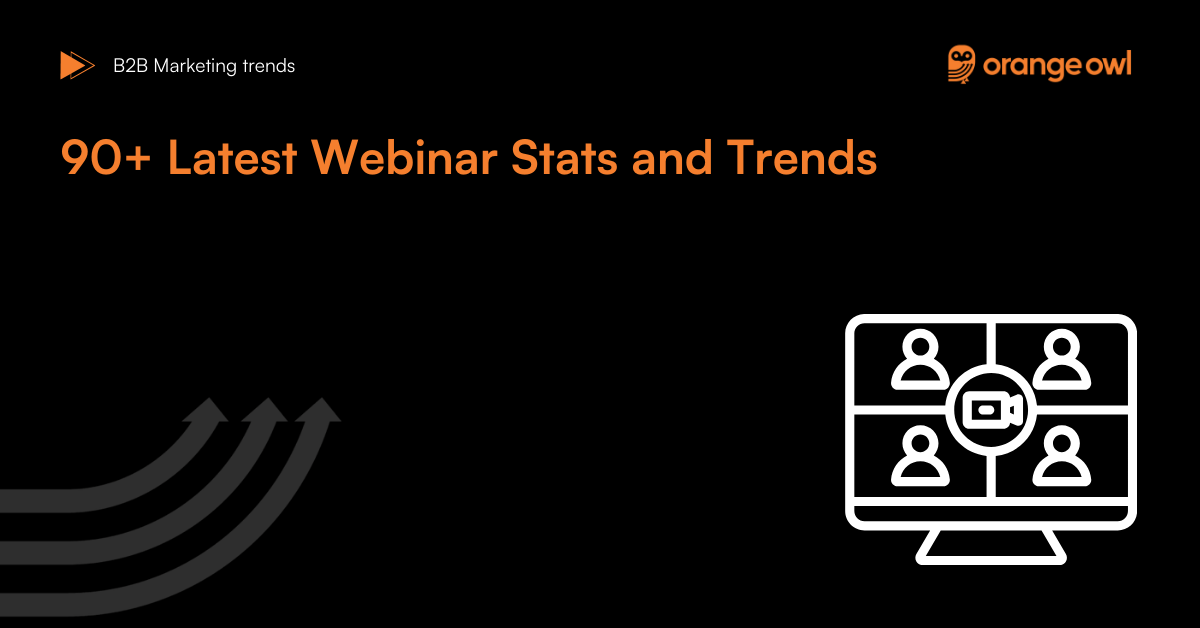
Table of Contents
Unlock the potential of webinars for B2B marketing, video marketing, and GTM strategies in 2024! Dive into the latest webinar stats to enhance engagement and captivate your audience.
Master the art of successful webinars with insights from over 90 statistics. Elevate your approach and transform your webinars from one-way communication to interactive experiences.
Discover top strategies to connect with your audience dynamically. With the latest trends, make your webinars stand out and resonate. Stay ahead with cutting-edge statistics tailored for 2024. Boost engagement, interaction, and turn every webinar into a success!
What are Webinars?
Webinars are online engaging events hosted by an individual or a group to communicate with a virtual audience who participate through interactive tools and often include a presentation, instructional session, or discussion.
What is Webinar Marketing?
Webinar marketing is a type of strategy that involves using webinars to promote a service, product, or brand. Most marketing webinars are lead-generation tools and they also nurture these leads into potential customers. Webinars can also get attendees to buy products and services, but we need to consider the fact that lead-generation webinars should add value to the attendees, and not be a sales pitch.
Are Webinars really needed?
For anyone starting a business, a webinar is one such way that allows you to reach out to a wider segment of the audience. But it doesn’t limit itself to new businesses, established businesses also incorporate webinars into their marketing strategies to connect to potential clients.
Benefits of hosting a Webinar:
Engage your Audience:
It is always crucial to have a strong connection with your audience to build your sales funnel and generate leads. If your goal is to earn a loyal set of customers, then webinars are the go-to option as they go beyond simply posting online reviews and social media posts. Webinars give people an opportunity to connect directly with businesses.
Generate Leads:
Webinars are powerful lead generation tools as they attract the right set of contacts because only people who are interested will subscribe to the event. This means that there is already a sense of familiarity or curiosity about your business, giving them a higher potential to convert after a session.
Increase Audience Engagement:
Acquiring a new customer is always tough but comparatively retaining an existing one is easy and one of the best ways to maintain a relationship with them is to keep them engaged. So, through webinars, presenters can become the face of your brand and can build trust and credibility webinars also offer a scope for interaction as people can participate in Q&A sessions, polls, and even via live chat.
Now that you know about the advantages of conducting a webinar, you would be eager to explore more webinar statistics to understand it better and in this process, you might be posed with some questions like
- How effective are Webinars?
- What are the best practices for hosting webinars?
- When is the perfect time to send invites and host them?
- What are the effective webinar promotion channels?
So, in this massive list of webinar statistics be sure to get your answers and much more. Here you’ll learn everything you need right from audience behavior, and engagement levels to the overall performance of webinar statistics.
These webinar statistics have been compiled from over a dozen different studies and reports, offering a well-grounded and comprehensive view.
Top Webinar Stats and Trends
1. Webinars anywhere from 46 to 60 minutes attract the most. – GoToWebinar
2. Most of the respondents of the survey conducted by GoToWebinar feel that webinars are a useful tool for engagement, 46% of respondents feel that webinars are the perfect tool for training purposes, and 24% agree that it is useful in marketing. – GoToWebinar
3. 69% of respondents from the ON24 report say that webinars enable them to scale their marketing efforts. – Hushly
4. Webinars scheduled at 11 am local time attract the most registrations. – Hushly
5. The ON24 report states that 75% agree that webinars help them to increase their brand reach. – Hushly
6. 37% is the average attendance rate for marketing webinars. – GoToWebinar
7. 37% of audience registrations occur 1-7 days before the webinar, which is when maximum registrations occur. – ON24
8. 24% of all webinar registrations occur on Tuesdays. – GoToWebinar
9. 96% of B2B buyers view webinars or video content at least once per month. – Webflow
10. 69% of webinars offered downloadable resources for attendees to engage with. – ON24
General Webinar Stats

Data source: GoToWebinar
We can see that a massive 61% of webinars are conducted by B2B companies as webinars are helpful for them to generate leads, nurture the existing ones, and help them establish themselves as a credible business. Also, Webinar acts as a platform for businesses to demonstrate their products which helps them to show their expertise level. We see that only 2% of Government Institutions use webinars as they cater to a broader segment of people and webinars might not be the most efficient way.
1. The global Webinar and Virtual events market is set to reach $ 4.4 billion in 2025. – Storefrost
2. Though good webinars take time to be put together, 80% say that webinars are easy to create. – Hushly
3. 53 minutes is the average viewing time of all types of webinars. – ON24
4. The average number for webinar attendees is 202 attendees and these numbers have risen year over year for every quarter. – ON24
5. 56 participants is the average attendee size for marketing webinars. – GoToWebinar
6. Only 41% of marketers have hosted or participated in a webinar and 83% found it to be an effective strategy. – Wyzowl
7. 64% of B2B marketers have organized webinars. – Contentmarketinginstitute
8. A report states that 61% of webinars are conducted by B2B companies. – GoToWebinar
9. 29% of webinars are held by SaaS companies. – Contentmarketinginstitute
10. 12% are hosted by financial companies. – Contentmarketinginstitute
11. 11% of webinars are held by consulting giants. – Contentmarketinginstitute
12. Less than 2% of webinars are conducted in tourism, real estate, and the nonprofit sector. – Contentmarketinginstitute
13. A wide range of industries use webinars for education, marketing, and training purposes but software and tech companies use them the most 30%. – GoTOWebinar
14. Running a webinar costs between $1000 to $3000 but they can be as low as $100 too. – Contentmarketinginstitute
15. 83% of respondents from a study say that they add custom design elements such as icons and backgrounds to their webinars. – Cfainstitute
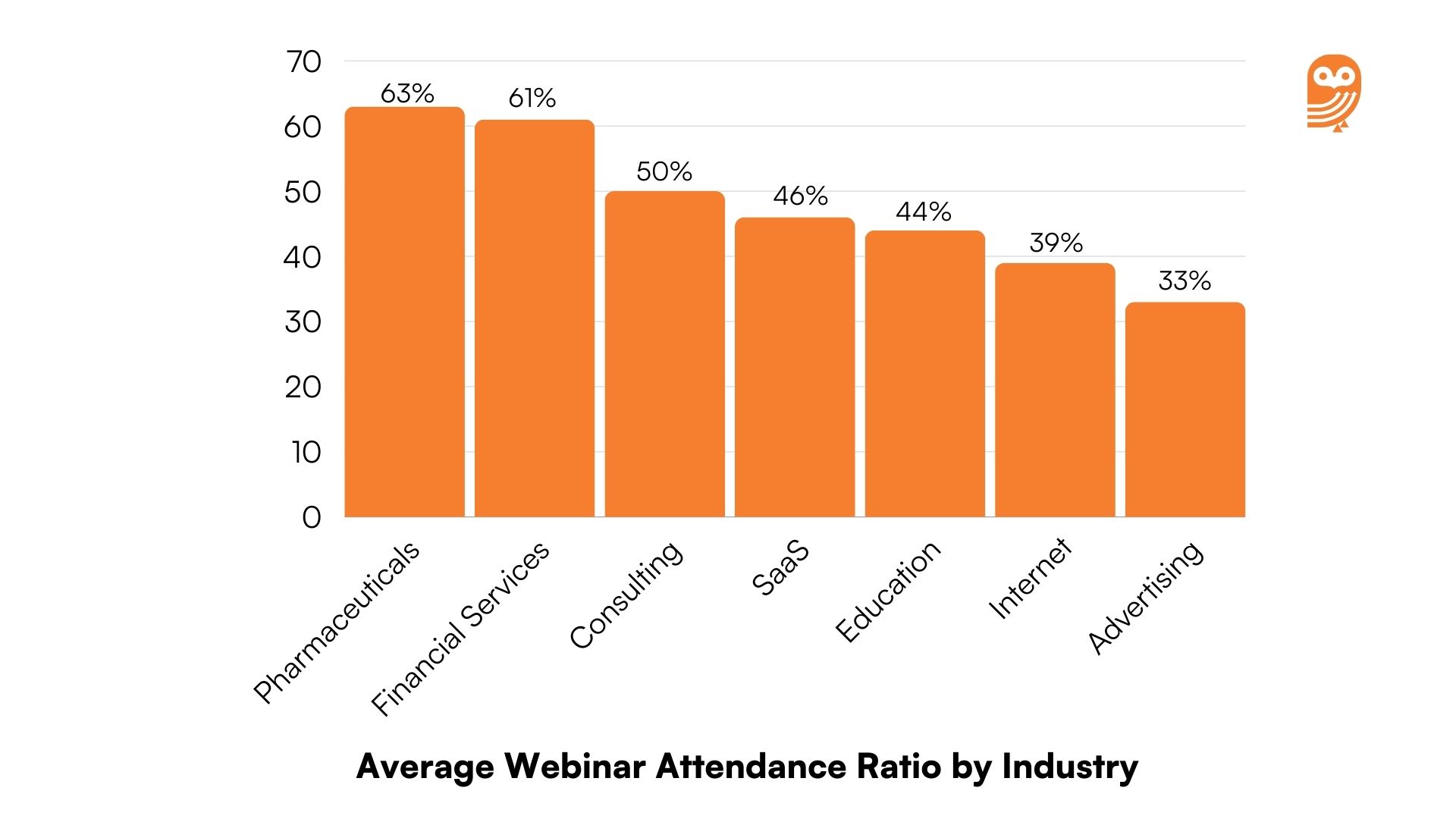
Data source: ContentMarketingInstitute
Webinar Marketing Strategies
Marketers incorporate webinars into their demand generation strategies as they are effective tools for lead generation. Most of the successful webinars start their promotion at least 15 days (about 2 weeks) prior to having a good audience reach and it also helps them to keep the webinar alive in the minds of the customers.
1. 87% of sales and marketing leaders incorporate webinars into their demand generation strategies. – Contentware
2. 69% of marketers say that they plan their webinars at least 3 months in advance. (- Cfainstitute
3. ON24 states that the most successful webinars start promotion at least 15 days in advance. – Hushly
4. According to Content Marketing Institute 58% of marketers use webinars for promotion. – Contentmarketinginstitute
5. The best time to promote webinars is 9 am. – GoToWebinar
6. 95% of marketers agree that webinars represent a key part of their marketing efforts. – Hushly
7. 38% of marketers consider webinars to be critical to their digital communications. – Hushly
8. 49% say that webinars enable them to reach targeted accounts. – Hushly
9. 65% say that they provide up to 5 marketing touches per webinar experience. – Hushly
10. Saturdays and Sundays are the worst days to promote webinars through mail, as only 5% respond to those emails. – Hushly
11. 68% say that webinars help tie their marketing activity to revenue. – Cfainstitute
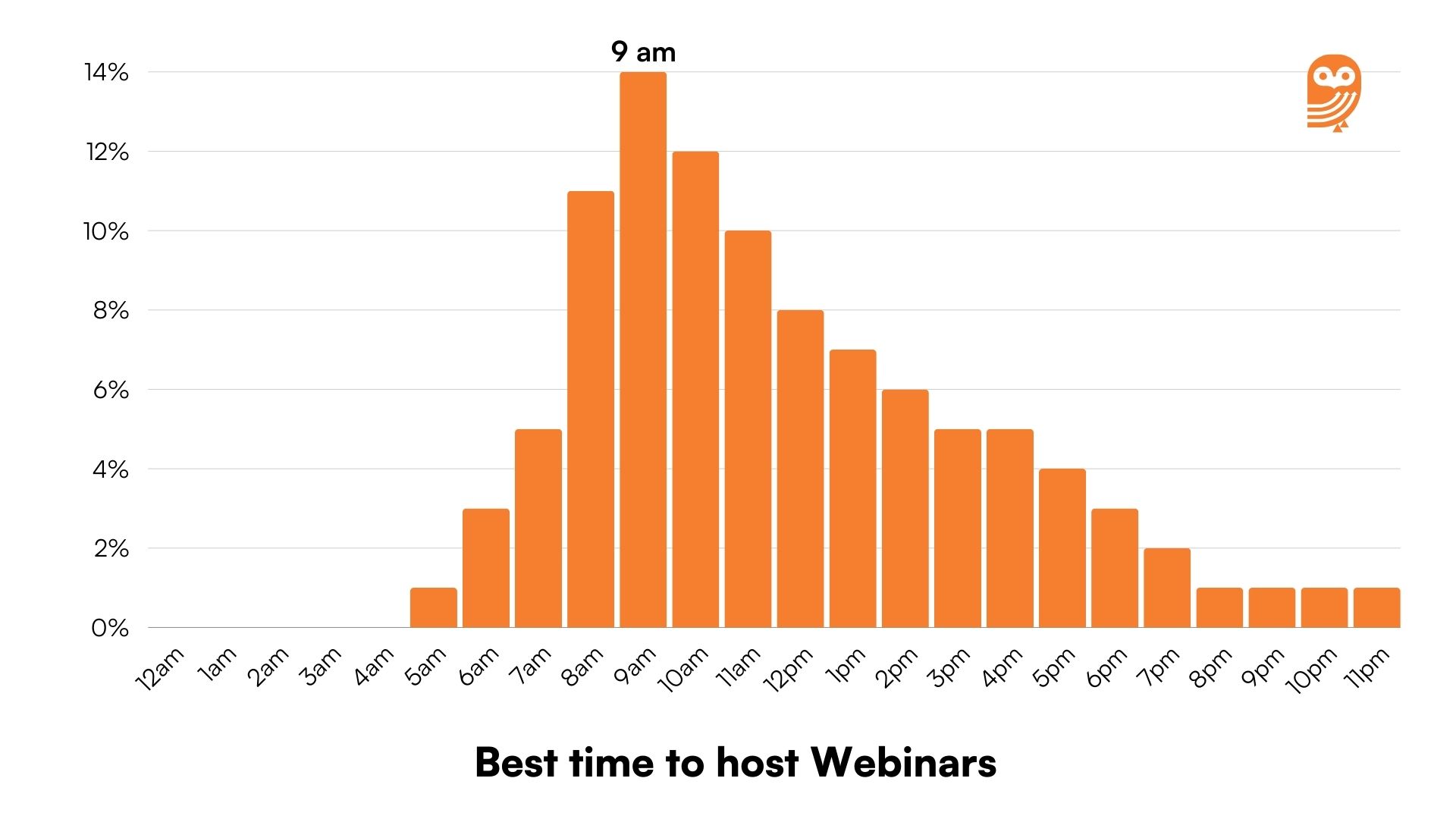
Data source: GoToWebinar
Attendee Stats and Trends
Most of the webinars are used for training purposes because they provide access to a lot of industry experts and professionals who might not be accessible otherwise. The attendees can talk directly to them, gain valuable insights, and ask questions related to their field to know more.

Data source: GoToWebinar
1. 91% of attendees state that webinars are their top learning format. – Searchenginejournal
2. 84% of professionals claim that they participate in webinars to stay up to date with the latest developments in their industries. – Webflow
3. 78% of webinars have 50 or fewer attendees. – Webflow
4. GoToWebinar states that 42.4 is the average attendee score for demand-generation webinars. – GoToWebinar
5. 32% of the attendees are engaged if the host is passionate about the topic. Bigmarker
6. 92% of attendees expect the webinar to end with a Q&A session. – Bigmarker
7. According to ON24, there has been a 40% increase in breakout room participants. – ON24
Webinar Registration Stats and Trends
In B2B marketing, email automation is a personal assistant—it keeps things organized and running smoothly. By automating emails, it saves time and ensures that messages are sent consistently. As well as it lets you personalize your emails making them more relevant and engaging.
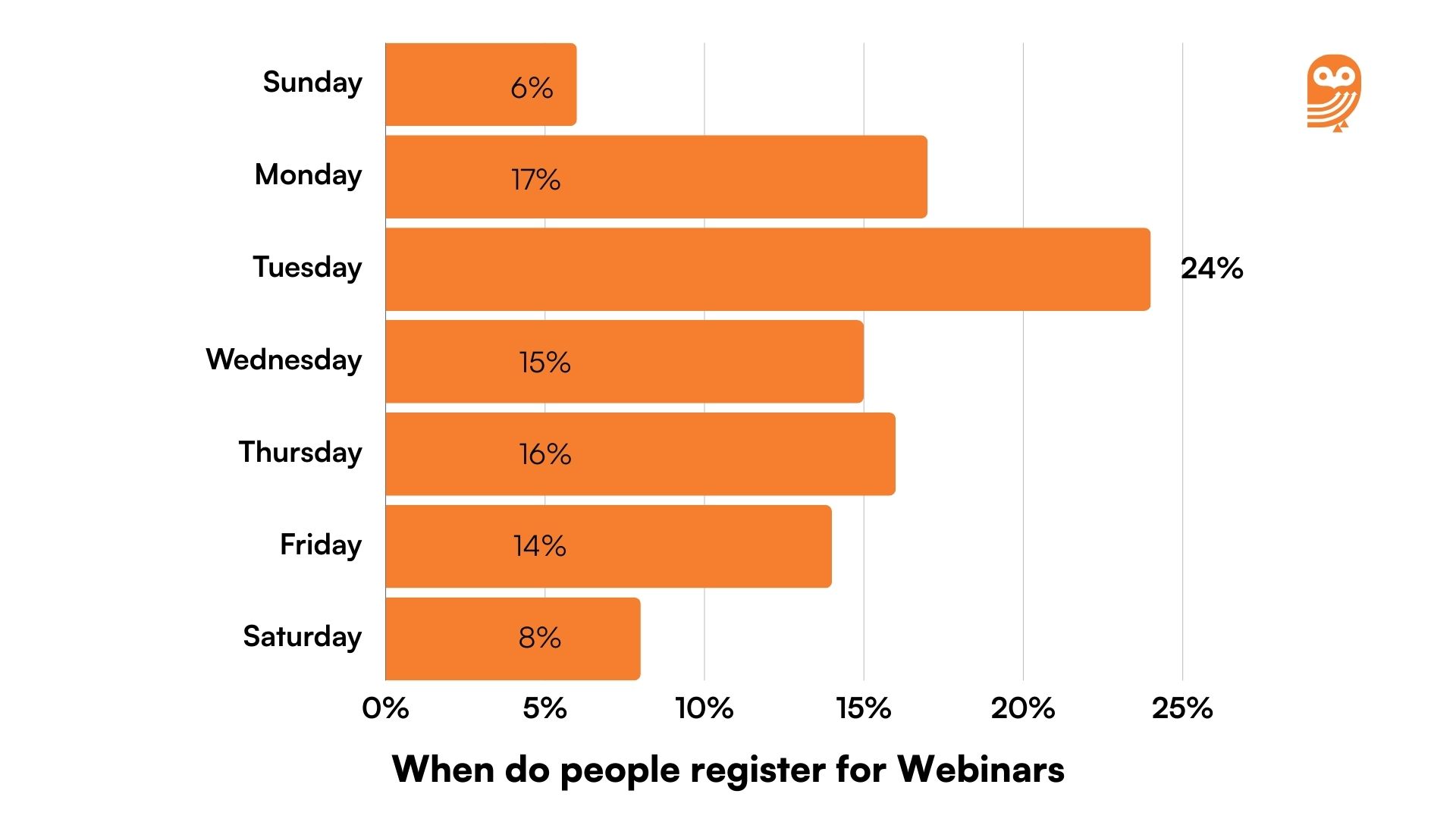
Data source: GoToWebinar
1. The conversion ratio of webinar registrations to attendees is around 56%. – ON24
2. A 35%-45% conversion rate is typically considered to be good. – Hushly
3. Events with more than 100 attendees have an average conversion rate of 43.4%. – Hushly
4. A report from Hushly says that training (45%) and communications (67%) see the highest conversion rates. – Hushly
5. 57% of registrations come from email, so you know where you should be putting your effort! – GoToWebinar
6. 60-minute webinars attract 2.1X more registrations than 30-minute webinars and 90-minute webinars attract 4.6X as many. – GoToWebinar
7. Research shows that the perfect number of fields on your registration page is between 5 & 7. – Contentmarketinginstitute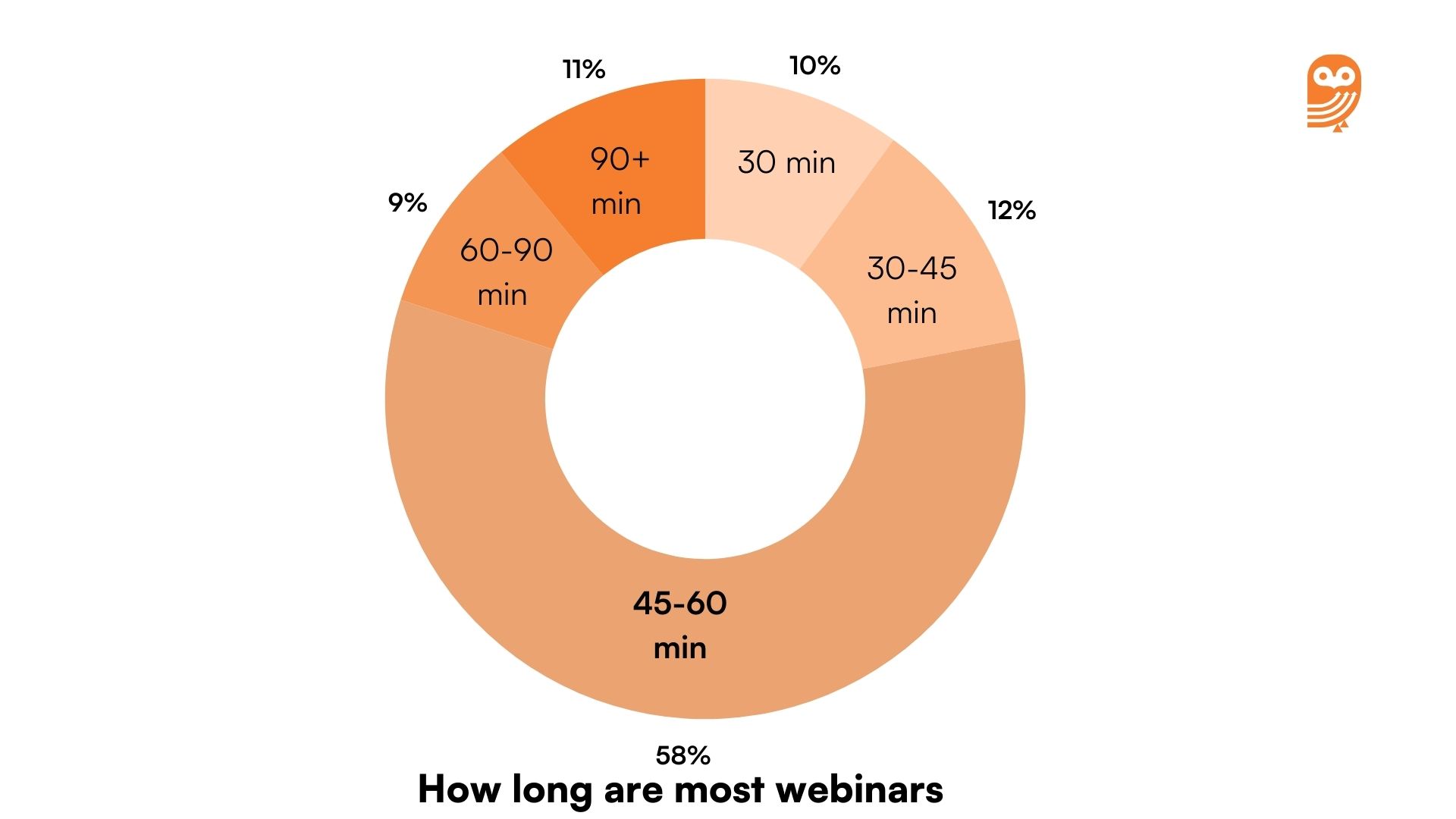
Data source: GoToWebinar
Engagement Stats and Trends
A Q&A session at the end is the most important part of the webinar because at this time the attendees can directly interact with the presenters, and it is a chance for them to clear up their doubts and understand the offering better. 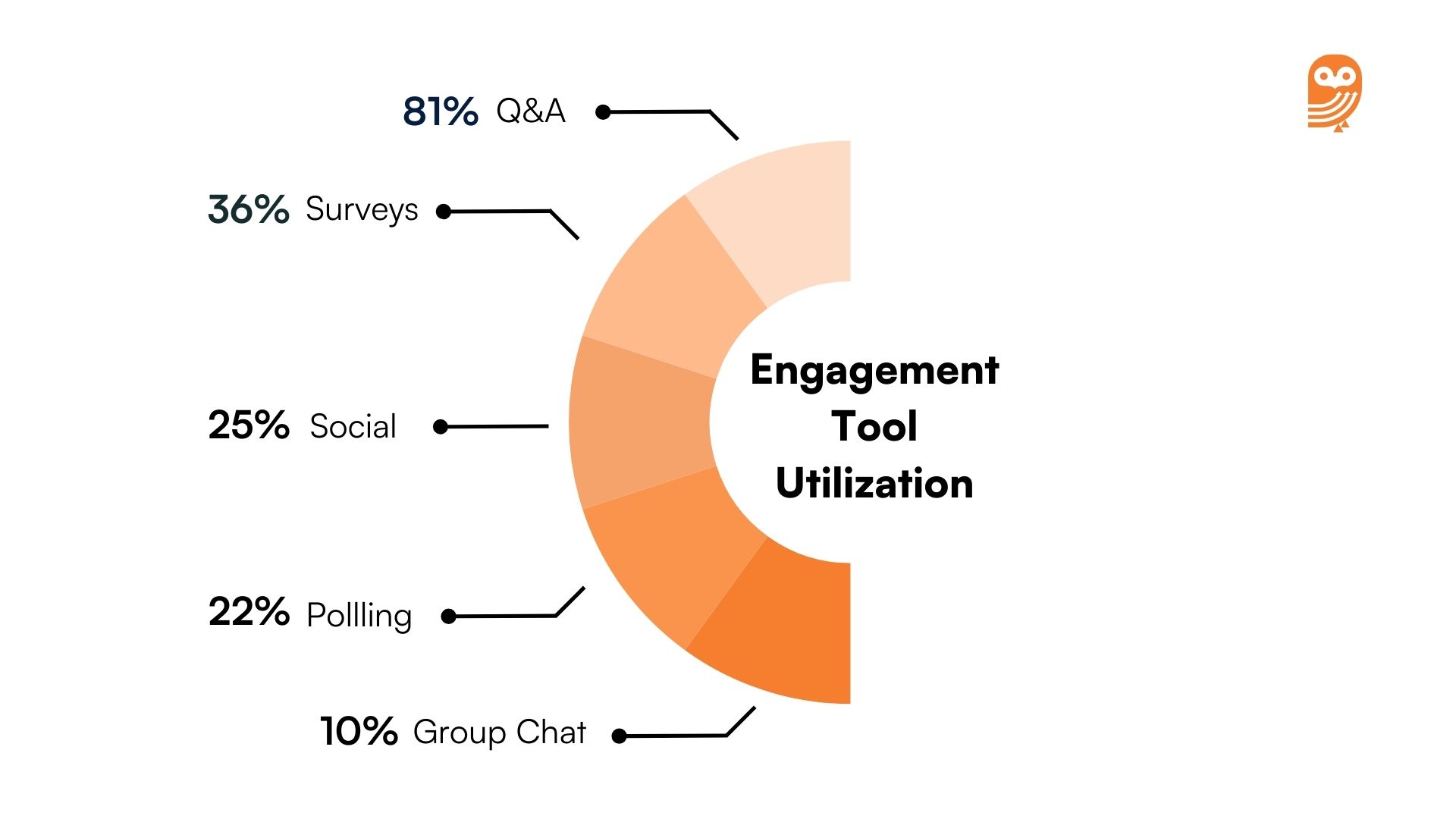
Data source: Hushly
1. There has been a 38% increase in engagement reactions in the webinar channel since 2022. – ON24
2. Personalized experiences saw a 68% increase in engagement. – ON24
3. 95% of respondents to the survey conducted by On24 agree that webinars are used to generate leads. – Hushly
4. According to GoToWebinar, 73% of B2B marketers and Sales leaders agree that webinars are the most effective method for generating high-quality leads. – GoToWebinar
5. There has been a 20%+ increase in interactions per webinar attendee since 2022. – ON24
6. According to a survey by ON24, 38% of respondents consider the quality of leads generated through webinars to be above average (4 or 5 on a 5-point scale). – ON24
7. 96% of B2B buyers view webinars or video content at least once per month. – Webflow
8. Over 54% of B2B participants engage with webinars on a daily or weekly basis. – Searchenginejournal
9. 60% of webinars are designed to move people through the entire life cycle right from unaware prospects to a loyal customer. – GoToWebinar
10. 23 is the average number of webinars conducted in a year. – GoToWebinar
11. 45% of marketers use email in their webinar promotion, making email the number 1 go to channel of promotion. – GoToWebinar
12. 40% of all demand-generation webinars use some type of engagement features like polls, surveys, and handouts. – GoToWebinar
13. Only 22% of webinars use polls. – Hushly
14. According to ON24, 53% of respondents say that it is extremely important to have access to engagement insights, as these will be able to provide more targeted follow-up. – Hushly
15. 55% of respondents say that the sales teams prioritize leads from webinars. – Cfainstitute
16. 88% of respondents of a survey, integrate their webinars with a CRM or marketing automation platform. The integration of webinar data into a CRM system will help the sales team to have immediate access to insights and they will be able to provide a more targeted follow-up. – Hushly
17. About 1 and a half weeks after an event, if the recordings are available, then you could still have 47% views and that number slowly drops to 24% after 20 days and then to 10% by the end of the month. – Hushly
18. 38% of all webinars feature some type of video. – Hushly
19. 63% of respondents from a survey conducted by Hushly, say that Q&A widgets typically drive the most engagement. – Hushly
Effective Schedule Stats and Trends
Scheduling a webinar time is also an essential part because we need to consider the time that drives more traffic. A lot of reports consider 11 am to be the best time for webinars as it is the most convenient time because it’s not too early or too late.

Data source: GoToWebinar
1. 55% of B2B marketers use Webinars to manage content marketing. – Contentmarketinginstitute
2. Tuesday (24%), Wednesday (26%) and Thursday (26%) are the days where audiences watch webinars the most. So, be sure to schedule your webinars on these days. – ON24
3. According to a report by GoToWebinar, the best time to promote is from 8 am to 10 am as there is a spike in registrations during that time and try avoiding sending emails later in the day where there is a high chance of being neglected. – GoToWebinar
4. 1 pm is not considered to be the right time for webinars as only 5% of people will be willing to attend. – Hushly
5. Even for a 90-minute webinar, 70% of attendees stay till the end. – GoToWebinar
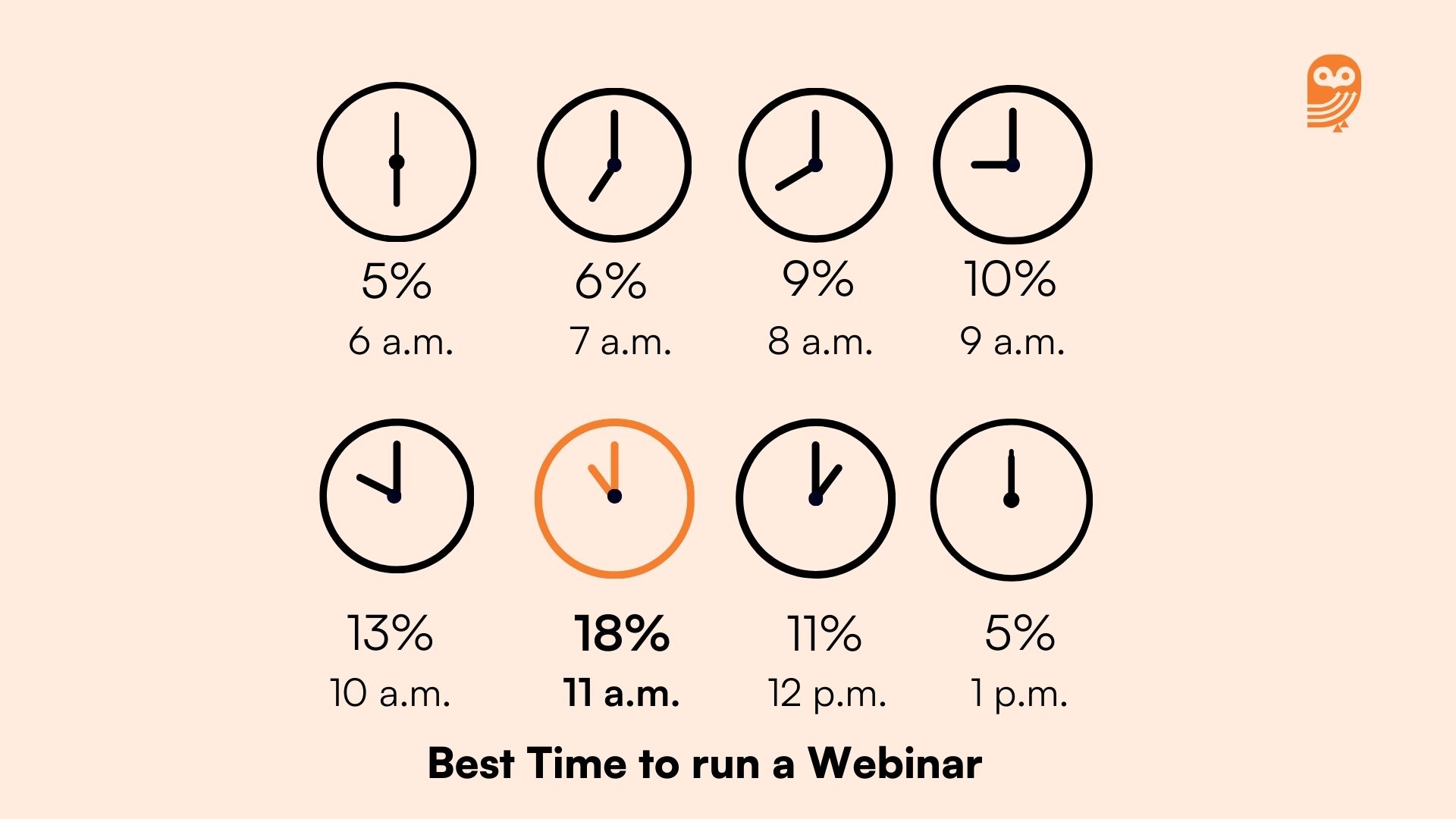
Data source: GoToWebinar
Webinar Software Stats and Trends
We can see that 93% of webinars use webcams, so one need not be worried about the unavailability of high-end software and tools. We can also see that a lot of webinars are now offering on-demand videos that can be viewed immediately.
1. A designated website hosting software is used by 74% of people rather than a general video-sharing platform. – Contentmarketinginstitute
2. 25% of webinars are viewed through mobile phones. – Contentmarketinginstitute
3. 94% of webinars are available on-demand after the event runs live. – Workcast
4. Around 44% of your audience will watch the on-demand version of the webinar. – ON24
5. 18% of views for the on-demand webinar take place on Saturdays and Sundays. – Workcast
6. We can also see a 13% increase in engagement in on-demand webinars. – ON247. 7. 3% of attendees watch both live and on-demand webinars. This is the segment that becomes a target audience for the companies. – ON24
8. In most of the cases, webinars retain 40% of viewers’ attention. – ON24
Webcams are used in 93% of webinars. – Hushly
9. 74% use a tool to host always-on webinars. – Hushly
10. 59% use a special page on their website to host webinars. – Hushly
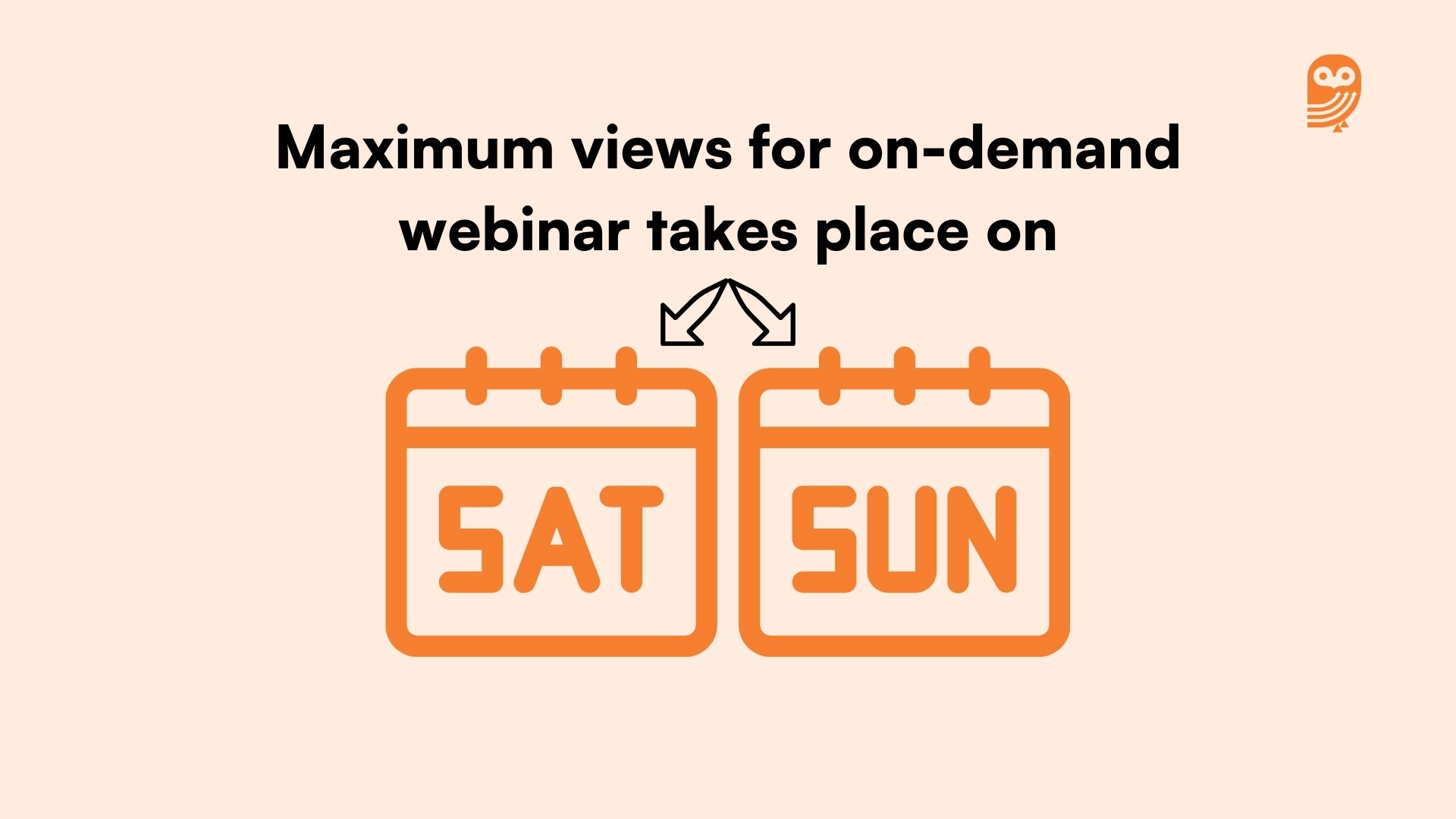
Data source: Workcast
Webinar Content Stats and Trends
1. Most B2B professionals want inspiration and actionable insights from webinars and 70% of them look for tips and tricks. – Webflow
2. 62% of B2B professionals want industry trends and predictions in webinars. – Webflow
3. Webinar landing pages can have a conversion rate as high as 51%. – GoTOWebinar
4. Since 2022, there has been a 56% increase in requests for a demo in the webinar channel. – ON24
5. 68% of top-performing marketers are very confident in creating personalized, relevant, and timely content. – Cfainstitute
6. 35% of respondents say that they highlight customer success stories in their webinars. – Cfainstitute

Data source: Driftclick
Remote Stats and Trends
1. According to GoToWebinar, 92% of professionals believe that webinars are the most effective method to engage a sizable remote audience. – GoToWebinar
2. 43% of remote and in-house teams use a video conferencing tool for webinars. – Getvoip
Key Takeaways – Latest Webinar stats and trends for 2025
Unlock the ultimate insights into webinar stats and trends for 2025 with these key takeaways.
- Q&A sessions stand as the ultimate engagement opportunity, while personalized experiences emerge as top trends driving attendee interaction.
- Leveraging email for promotion remains a top strategy, with optimal webinar scheduling on Tuesdays, Wednesdays, or Thursdays between 8 am and 10 am.
- Webcams and on-demand viewing options are the ultimate tools for enhancing engagement and retention.
- When crafting webinar content, focus on delivering top insights into industry trends, actionable strategies, and impactful demos to resonate with audiences in 2025.
Additionally, prioritize engaging remote audiences through video conferencing tools for ultimate reach and impact.
Conclusion
In conclusion, these webinar statistics highlight their pivotal role in the marketing domain. These statistics reveal how webinars attract high audience engagement, boost lead generation, and offer a cost-effective way to connect to audiences globally. Businesses can use these insights to optimize their webinar strategies and achieve their marketing goals.
Frequently Asked Questions (FAQs) about the Latest Webinar Stats and Trends
A webinar is a presentation, lecture, or workshop which is conducted over the web using video conferencing software. It allows the host to share their presentations, and conduct surveys, and also allows the audience to participate in polls and Q&A sessions, all in real-time.
The main purpose of the webinar is to educate and share information about a product or service with a large group of audience in real time. Webinars are also used for training sessions, corporate meetings, sales pitches, and more.
- Promote your webinar well in advance
- Choose an interesting trending topic
- Study your audience to connect better
- Plan cross-channel webinar marketing
- Provide value in your webinar content
The ideal length of a webinar should be around 46-60 minutes to grab maximum attention and one can also expect almost all attendees to be present till the last.
16.1% agree that the best time to conduct a webinar is 11 am.
Webinars can be live, simulive or on-demand and 94% of webinars are available on-demand after the event runs live.
The conversion ratio of webinar registrations to attendees is around 56%.
24% of people agree that Tuesdays are the best days to send registration mails.
- Attendance Conversion rate: The number of registered users who actually participated in the webinar
- Lead generation: The number of potential leads who were converted into customers
- Audience Engagement: Feedback taken from the audience after the webinar
- Increased brand awareness: The number of website visits after the webinar
- Audience retention: The percentage of audience who sit through the entire webinar
- Registration rate
- Attendance rate
- Engagement duration
- Cost per lead (total costs divided by the number of leads acquired)
- Landing page views
- Landing page conversion rate (number of registrations divided by number of landing page views)
- Email opens/clicks


